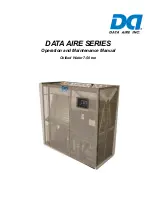
17
5.9 - Additional electric heater stage control
As an option, the heat pump units can control up to four
additional electric heating stages.
The electric heating stages are activated to complement the
heating capacity when the following conditions are satisfied:
•
The unit uses 100% of the available heating capacity,
or the unit is limited in its operation by a protection
mode (low suction temperature, hot gas or defrost
sequence in progress protection), and in all cases cannot
satisfy the heating load.
•
The outdoor temperature is below a configured
threshold (see HCCONFIG configuration).
•
Unit capacity limitation is not active.
The user may configure the last available electric heating
stages as a safety stage. In this case, the safety stage is only
activated in addition to the other stages if there is a
machine fault, preventing the use of the heating capacity.
The other electric heating stages will continue to operate
as described above.
5.10 - Control of a boiler
The unit can control the start-up of a boiler. When the boiler
is operating, the unit water pump is stopped. A heat pump
unit and a boiler cannot operate together.
In this case the boiler output is activated in the following
conditions:
•
A fault prevents the use of the heat pump capacity.
•
The unit works at a very low outside temperature,
making the heat pump capacity insufficient. The outside
air temperature threshold for use of the boiler is fixed at
-10°C, but this value can be adjusted in the HCCONFIG
menu.
NOTE: The control of the electric heating stages or of a
boiler is not authorised for slave units.
5.11 - Eco function
The 61AF units include an Eco function. This function is
based on the circulating refrigerant flow and allows
maintaining the superheat setpoint. The function is not
available during defrost and during the first minute of
operation.
The objective of this function is to obtain higher performan-
ces and improved efficiency.
5.12 - Master/slave assembly
Two Pro- units can be linked to produce a master/
slave assembly. The two machines are interconnected over
the CCN bus. All parameters required for the master/slave
function must be configured through the Service configura-
tion menu.
Master/slave operation requires the connection of a tempe-
rature probe at the common manifold on each machine, if
the heat exchanger leaving water temperature is controlled.
It is not required, if the entering water temperature is
controlled.
The master/slave assembly can operate with constant or
variable flow. In the case of variable flow each machine
must control its own water pump and automatically shut
down the pump, if the cooling capacity is zero.
For constant flow operation the pumps for each unit are
continuously operating, if the system is operating. The
master unit can control a common pump that will be
activated, when the system is started. In this case the slave
unit pump is not used.
All control commands to the master/slave assembly (start/
stop, setpoint, heating mode operation, load shedding, etc.)
are handled by the unit which is configured as the master,
and must therefore only be applied to the master unit. They
will be transmitted automatically to the slave unit.
The master unit can be controlled locally, remotely or by
CCN commands. Therefore to start up the assembly, simply
validate the Master operating type (Master) on the master
unit. If the Master has been configured for remote control
then use the remote volt-free contacts for unit start/stop.
The slave unit must stay in CCN operating type continuously.
To stop the master/slave assembly, select Local Off on the
master unit or use the remote volt-free contacts if the unit
has been configured for remote control.
One of the functions of the master unit (depending on its
configuration) may be the designation, whether the master
or slave is to be the lead machine or the follower. The roles
of lead machine and follower will be reversed when the
difference in running hours between the two units exceeds
a configurable value, ensuring that the running times of the
two units are automatically equalised.
The changeover between lead machine and follower may
take place when the assembly is started up, or even whilst
running. The running time balancing function is not active
if it has not been configured: in this case the lead machine
is always the master unit.




































